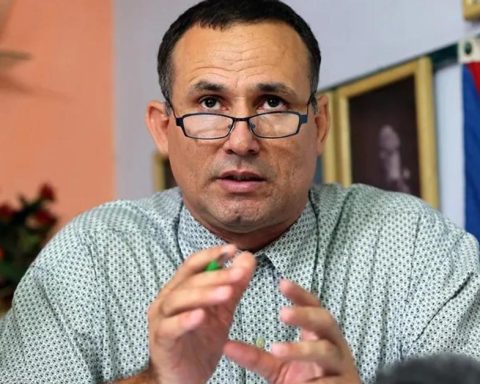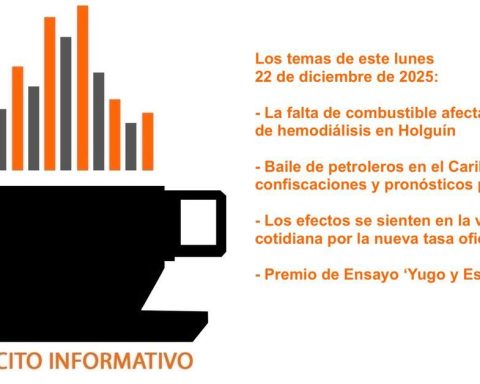The giant of the Cuban fresh waters is not an autochthonous fish and neither does it reach the tables of ordinary families. The paiche or arapaima, which can reach up to 250 kilograms and three meters in length, was introduced into the country more than forty years ago and is a delicacy destined for the dishes of senior leaders and their families.
Although huge in size and highly valued meat, the arapaima is a species almost unknown to Cubans. Except for a few sightings in dams or lagoons, most island residents do not know that there is a breeding program for this giant from the Amazon and that feasts with this fish are frequent among Party leaders.
In the Higuanojo dam, in Sancti Spíritus, “paiche is raised but it is permanently closed. It is only fished by authorized people and to take it to Havana, specifically for the families of Punto Cero and others in the area of El Laguito and Atabey “, account to 14ymedio a local employee who prefers anonymity. “A complete team is coming that includes members of State Security, veterinarians and expert fishermen,” she clarifies.
“Since they don’t want the animal to get hit or lose scales, then an entanglement is made to push it little by little until it can be removed from the water,” he explains. “He has to arrive in Havana in perfect condition, because the same thing ends up in the house of a general, a minister, or a meal with a foreign delegation that is visiting the country.”
Fidel Castro took advantage of the occasion to remember how the species had arrived on the island and to boast that Cuba exported the product to European destinations
“It is a very versatile, soft meat, with which you can prepare a good broth and it does not have that earthy flavor that appears in other species of freshwater fish,” Bernabé González, a chef who emigrated to this newspaper, details He has been to the United States for more than a decade but he remembers having cooked on the Island the also known as “Amazonian cod”.
“My cooking teacher was an expert in doing it, because he had worked for several years in the system of protocol houses where presidents and high-ranking foreign officials who arrived in Cuba stayed,” he recalls. “It used to be common to serve that fish in ceviche or cooked to a crisp, but it can also be served with a honey-based sauce. Many types of sauce work well.”
González remembers taking some pieces of arapaima for his family. “One day when we had to prepare a dinner for the family of a commander, I took a piece with me. My children went crazy with that and they asked me why they didn’t sell something like that in the fishmongers. I had to tell them that this was only for well-to-do people positioned”.
The exclusive destiny of the paiche in Cuba is described in a testimony of the Peruvian José Torres Muga. Invited to a celebration at the Palace of the Revolution in Havana, the diplomat was surprised that the dinner included a “giant paiche.” Along with yucca with mojo and congrí, that enormous delicacy fed the ambassadors of the Latin American and Caribbean Group.
In response to questions from the diners about the origin of the fish, Fidel Castro took advantage of the occasion to recall how the species had arrived on the island and to boast that Cuba exported the product to European destinations. It was 1994, one of the hardest years of the Special Period in Cuba and getting any type of meat in the markets had become a headache.
“There have been cases of peasants in the area coming to steal these fish. To do so they have to come with tractors because they are very large and heavy when removing them from the water”
The arrival of the first specimens of arapaima to the island, a fish also known as pirarucú or paiche, dates back to the 1970s. In August 1974, a Cuban delegation headed by Raúl Castro visited Peru, during the presidency of Juan Velasco Alvarado. , and among the activities he carried out was a visit to the Pacaya national reserve. The then Minister of the Armed Forces was captivated by the natural beauties of the place and, especially, by the fishing projects in the area.
On that trip, he took several specimens on the Cubana de Aviación plane in which he was traveling to entertain his brother and in the following years, Castro organized thousands of fingerlings of various species, including arapaima, to be brought to the island. The fish began to be raised in three points on the island, including the Higuanojo dam in Sancti Spíritus, where area residents nicknamed it “apache”, a local adaptation of “paiche”.
“There have been cases of peasants in the area coming to steal these fish. To do so they have to come with tractors because they are very large and heavy when removing them from the water. There is also surveillance to prevent these events, but the temptation is very strong because with a single specimen a family eats for several days”.
With a flat head and scaly body, the paiche has a complex respiratory system, with gills and a swim bladder adapted like a lung, which allows it to breathe on the surface, and even survive for long minutes out of the water. “When the level of the dam drops a bit, people can find them more easily,” says the employee.
Although in the other two locations where the arapaimas arrived from Peru were originally located “there are practically no breeding sites left”, according to this worker from Spirit, “here we have a good number of specimens”. The man also warns that the reservoir has suffered several problems for which they have had to alleviate and “the fish have escaped.”
After several telephone calls made by this newspaper to fishmongers located in different provinces of the country, the response was unanimous: “We have never sold that fish.”
“Some were caught by the peasants of the area themselves, but others are around from time to time someone reports that they saw a huge fish and they must be the ones that got loose from here.” In 2007, the Granma newspaper published that “workers of the aquaculture company and fishing enthusiasts from the central Cuban province of Sancti Spíritus” had confirmed the existence of a giant fish in the Zaza’s Damwhich they call “freshwater shark”.
The official organ of the Communist Party assured that the specimens had arrived from the Higuanojo reservoir through the Tuinucú river. The text did not mention the possible negative impact of this species, considered invasive in several countries of the continent, which may be causing the Cuban fauna. The paiche not only consume large amounts of fish but also small mammals and birds.
“More specimens were also brought here from Venezuela, when Hugo Chávez was alive,” he adds. “This has made it possible to maintain the population of this fish, which is not easy to breed and reproduce outside its natural habitat.” The man stresses that the ones they feed in the reservoir “were from Fidel [Castro] and now they have remained exclusively for his family or very close people”.
Two years ago, Cuban television broadcast a report on the introduction of the species at the La Sierpe Fingerlings Station, also in Sancti Spíritus. The entity’s director, Pedro Placencia Sosa, explained that it was planned to “intensively fatten them” to contribute their meat to the feeding of the population.
However, after several telephone calls made by this newspaper to fishmongers located in different provinces of the country, the response was unanimous: “We have never sold that fish.”
Among the workers of the reservoir where the paiches are raised in Sancti Spíritus, this end of the year when the shortage of food has hit the festivities hard on the Island, the hope is now focused on the exquisite diners coming to look for some fish in Havana and “someone takes a hit and, after losing quality, they don’t want to take it with them.” So they can distribute the exquisite meat of the giant of the Amazon.
________________________
Collaborate with our work:
The team of 14ymedio He is committed to doing serious journalism that reflects the reality of deep Cuba. Thank you for accompanying us on this long road. We invite you to continue supporting us, but this time becoming a member of our newspaper. Together we can continue transforming journalism in Cuba.
















